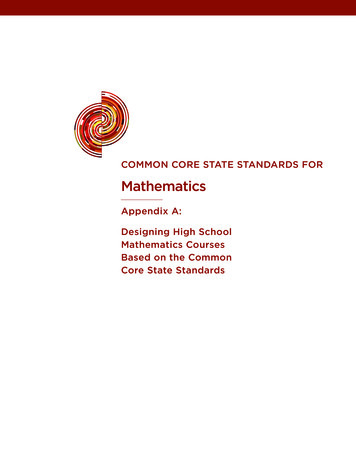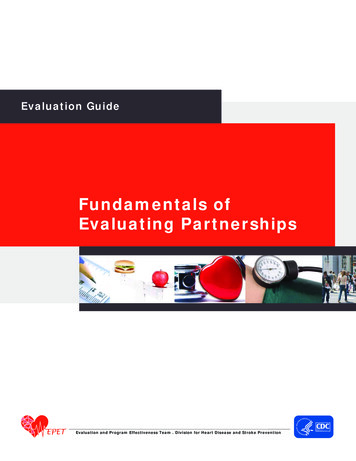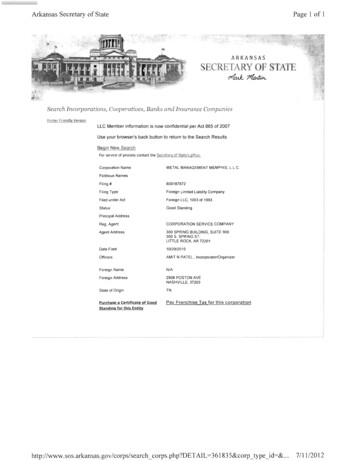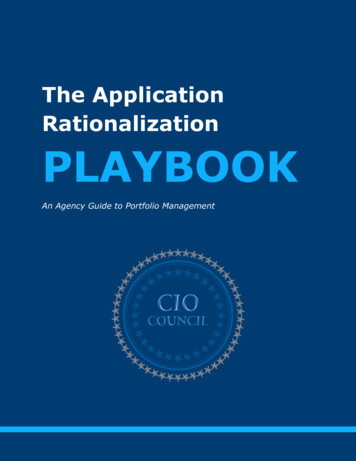
Transcription
common core state STANDARDS FORMathematicsAppendix A:Designing High SchoolMathematics CoursesBased on the CommonCore State Standards
Common Core State Standards for MATHEMATICSOverviewThe Common Core State Standards (CCSS) for Mathematics are organized by grade level in Grades K–8. At the highschool level, the standards are organized by conceptual category (number and quantity, algebra, functions, geometry,modeling and probability and statistics), showing the body of knowledge students should learn in each category tobe college and career ready, and to be prepared to study more advanced mathematics. As states consider how toimplement the high school standards, an important consideration is how the high school CCSS might be organizedinto courses that provide a strong foundation for post-secondary success. To address this need, Achieve (in partnership with the Common Core writing team) has convened a group of experts, including state mathematics experts,teachers, mathematics faculty from two and four year institutions, mathematics teacher educators, and workforcerepresentatives to develop Model Course Pathways in Mathematics based on the Common Core State Standards.In considering this document, there are four things important to note:The pathways and courses are models, not mandates. They illustrate possible approaches to organizing thecontent of the CCSS into coherent and rigorous courses that lead to college and career readiness. States anddistricts are not expected to adopt these courses as is; rather, they are encouraged to use these pathways andcourses as a starting point for developing their own.2.All college and career ready standards (those without a ) are found in each pathway. A few ( ) standards areincluded to increase coherence but are not necessarily expected to be addressed on high stakes assessments.3.The course descriptions delineate the mathematics standards to be covered in a course; they are not prescriptions for curriculum or pedagogy. Additional work will be needed to create coherent instructional programs thathelp students achieve these standards.4.Units within each course are intended to suggest a possible grouping of the standards into coherent blocks; inthis way, units may also be considered “critical areas” or “big ideas”, and these terms are used interchangeablythroughout the document. The ordering of the clusters within a unit follows the order of the standards documentin most cases, not the order in which they might be taught. Attention to ordering content within a unit will beneeded as instructional programs are developed.5.While courses are given names for organizational purposes, states and districts are encouraged to carefully consider the content in each course and use names that they feel are most appropriate. Similarly, unit titles may beadjusted by states and districts.While the focus of this document is on organizing the Standards for Mathematical Content into model pathwaysto college and career readiness, the content standards must also be connected to the Standards for MathematicalPractice to ensure that the skills needed for later success are developed. In particular, Modeling (defined by a * in theCCSS) is defined as both a conceptual category for high school mathematics and a mathematical practice and is animportant avenue for motivating students to study mathematics, for building their understanding of mathematics,and for preparing them for future success. Development of the pathways into instructional programs will requirecareful attention to modeling and the mathematical practices. Assessments based on these pathways should reflectboth the content and mathematical practices standards.appendix A: Designing high school mathematics courses based on the common core state standards 1.2
Common Core State Standards for MATHEMATICSThe PathwaysFour model course pathways are included:An approach typically seen in the U.S. (Traditional) that consists of two algebra courses and a geometry course,with some data, probability and statistics included in each course;2.An approach typically seen internationally (Integrated) that consists of a sequence of three courses, each ofwhich includes number, algebra, geometry, probability and statistics;3.A “compacted” version of the Traditional pathway where no content is omitted, in which students would completethe content of 7th grade, 8th grade, and the High School Algebra I course in grades 7 (Compacted 7th Grade) and 8(8th Grade Algebra I), which will enable them to reach Calculus or other college level courses by their senior year.While the K-7 CCSS effectively prepare students for algebra in 8th grade, some standards from 8th grade have beenplaced in the Accelerated 7th Grade course to make the 8th Grade Algebra I course more manageable;4.A “compacted” version of the Integrated pathway where no content is omitted, in which students would complete the content of 7th grade, 8th grade, and the Mathematics I course in grades 7 (Compacted 7th Grade) and 8(8th Grade Mathematics I), which will enable them to reach Calculus or other college level courses by their senioryear. While the K-7 CCSS effectively prepare students for algebra in 8th grade, some standards from 8th grade havebeen placed in the Accelerated 7th Grade course to make the 8th Grade Mathematics I course more manageable;5.Ultimately, all of these pathways are intended to significantly increase the coherence of high school mathematics.The non-compacted, or regular, pathways assume mathematics in each year of high school and lead directly to preparedness for college and career readiness. In addition to the three years of study described in the Traditional andIntegrated pathways, students should continue to take mathematics courses throughout their high school career tokeep their mathematical understanding and skills fresh for use in training or course work after high school. A varietyof courses should be available to students reflecting a range of possible interests; possible options are listed in thefollowing chart. Based on a variety of inputs and factors, some students may decide at an early age that they wantto take Calculus or other college level courses in high school. These students would need to begin the study of highschool content in the middle school, which would lead to Precalculus or Advanced Statistics as a junior and Calculus,Advanced Statistics or other college level options as a senior.Strategic use of technology is expected in all work. This may include employing technological tools to assist studentsin forming and testing conjectures, creating graphs and data displays and determining and assessing lines of fit fordata. Geometric constructions may also be performed using geometric software as well as classical tools and technology may aid three-dimensional visualization. Testing with and without technological tools is recommended.As has often occurred in schools and districts across the states, greater resources have been allocated to acceleratedpathways, such as more experienced teachers and newer materials. The Achieve Pathways Group members stronglybelieve that each pathway should get the same attention to quality and resources including class sizes, teacherassignments, professional development, and materials. Indeed, these and other pathways should be avenues for students to pursue interests and aspirations. The following flow chart shows how the courses in the two regular pathways are sequenced (the * in the chart on the following page means that Calculus follows Precalculus and is a fifthcourse, in most cases). More information about the compacted pathways can be found later in this appendix.appendix A: Designing high school mathematics courses based on the common core state standards 1.3
Common Core State StandardS for matHematICSA study done by ACT and The Education Trust gives evidence to support these pathways. The study looked at highpoverty schools where a high percentage of students were reaching and exceeding ACT’s college-readiness benchmarks. From these schools, the most effective teachers described their courses and opened up their classrooms forobservation. The commonality of mathematics topics in their courses gives a picture of what it takes to get studentsto succeed, and also provides a grounding for the pathways. (There were other commonalities. For more detailedinformation about this study, search for the report On Course for Success at www.act.org.)1Implementation considerations:As states, districts and schools take on the work of implementing the Common Core State Standards, the ModelCourse Pathways in Mathematics can be a useful foundation for discussing how best to organize the high school standards into courses. The Pathways have been designed to be modular in nature, where the modules or critical areas(units) are identical in nearly every manner between the two pathways, but are arranged in different orders to accommodate different organizational offerings. Assessment developers may consider the creation of assessment modulesin a similar fashion. Curriculum designers may create alternative model pathways with altogether different organizations of the standards. Some of this work is already underway. In short, this document is intended to contribute tothe conversations around assessment and curriculum design, rather than end them. Effectively implementing thesestandards will require a long-term commitment to understanding what best supports student learning and attainmentof college and career readiness skills by the end of high school, as well as regular revision of pathways as studentlearning data becomes available.supporting studentsOne of the hallmarks of the Common Core State Standards for Mathematics is the specification of content that allstudents must study in order to be college and career ready. This “college and career ready line” is a minimum for allstudents. However, this does not mean that all students should progress uniformly to that goal. Some students progress1The study provides evidence that the pathways’ High School Algebra I, Geometry, Algebra II sequence is a reasonable and rigorous option for preparing students for college and career. Topics aligned almost completely between the CCSS topics and topics taught in the study classrooms. The starting point for thepathways’ High School Algebra I course is slightly beyond the starting point for the study Algebra I courses due to the existence of many typical Algebra I topicsin the 8th grade CCSS, therefore some of the study Algebra II topics are a part of the pathways’ High School Algebra I course, specifically, using the quadraticformula; a bit more with exponential functions including comparing and contrasting linear and exponential growth; and the inclusion of the spread of data sets.The pathways’ Geometry course is very similar to what was done in the study Geometry courses, with the addition of the laws of sines and cosines and the workwith conditional probability, plus applications involving completing the square because that topic was part of the pathways’ High School Algebra I course. Thepathways’ Algebra II course then matches well with what was done in the study Algebra II courses and continues a bit into what was done in the study Precalculus classrooms, including inverse functions, the behavior of logarithmic and trigonometric functions, and in statistics with the normal distribution, margin of error,and the differences among sample surveys, experiments, and observational studies. All in all, the topics and the order of topics is very comparable between thepathways’ High School Algebra I, Geometry, Algebra II sequence and the sequence found in the study courses.appendIx a: deSIgnIng HIgH SCHool matHematICS CourSeS baSed on tHe Common Core State StandardS Some teachers and schools are effectively getting students to be college and career ready. We can look to theseteachers and schools to see what kinds of courses are getting results, and to compare pathways courses to the mathematics taught in effective classrooms.4
Common Core State Standards for MATHEMATICSmore slowly than others. These students will require additional support, and the following strategies, consistent withResponse to Intervention practices, may be helpful: Creating a school-wide community of support for students; Providing students a “math support” class during the school day; After-school tutoring; Extended class time (or blocking of classes) in mathematics; and Additional instruction during the summer.Furthermore, research shows that allowing low-achieving students to take low-level courses is not a recipe for academic success (Kifer, 1993). The research strongly suggests that the goal for districts should not be to stretch the highschool mathematics standards over all four years. Rather, the goal should be to provide support so that all studentscan reach the college and career ready line by the end of the eleventh grade, ending their high school career with oneof several high-quality mathematical courses that allows students the opportunity to deepen their understanding ofthe college- and career-ready standards.With the Common Core State Standards Initiative comes an unprecedented ability for schools, districts, and states tocollaborate. While this is certainly the case with respect to assessments and professional development programs, it isalso true for strategies to support struggling and accelerated students. The Model Course Pathways in Mathematicsare intended to launch the conversation, and give encouragement to all educators to collaborate for the benefit of ourstates’ children.appendix A: Designing high school mathematics courses based on the common core state standards Watered-down courses which leave students uninspired to learn, unable to catch up to their peers and unready forsuccess in postsecondary courses or for entry into many skilled professions upon graduation from high school areneither necessary nor desirable. The results of not providing students the necessary supports they need to succeed inhigh school are well-documented. Too often, after graduation, such students attempt to continue their education at 2or 4-year postsecondary institutions only to find they must take remedial courses, spending time and money mastering high school level skills that they should have already acquired. This, in turn, has been documented to indicate agreater chance of these students not meeting their postsecondary goals, whether a certificate program, two- or fouryear degree. As a result, in the workplace, many career pathways and advancement may be denied to them. To ensurestudents graduate fully prepared, those who enter high school underprepared for high school mathematics coursesmust receive the support they need to get back on course and graduate ready for life after high school.5
Common Core State Standards for MATHEMATICSHow to Read the Pathways:Each pathway consists of two parts. The first is a chart that shows an overview of the pathway. Organized by courseand by conceptual category (algebra, functions, geometry, etc ), these charts show which clusters and standardsappear in which course (see page 5 of the CCSS for definitions of clusters and standards). For example, in the chartbelow, the three standards (N.Q.1, 2, 3) associated with the cluster “Reason quantitatively and use units to solveproblems,” are found in Course 1. This cluster is found under the domain “Quantities” in the “Number and Quantity”conceptual category. All high school standards in the CCSS are located in at least one of the courses in this chart.CoursesDomainConceptualCategoryappendix A: Designing high school mathematics courses based on the common core state standards Clusters,Notes, andStandards6
Common Core State Standards for MATHEMATICSThe second part of the pathways shows the clusters and standards as they appear in the courses. Each coursecontains the following components: An introduction to the course and a list of the units in the course Unit titles and unit overviews (see below) Units that show the cluster titles, associated standards, and instructional notes (below)It is important to note that the units (or critical areas) are intended to convey coherent groupings of content. Theclusters and standards within units are ordered as they are in the Common Core State Standards, and are notintended to convey an instructional order. Considerations regarding constraints, extensions, and connections arefound in the instructional notes. The instructional notes are a critical attribute of the courses and should not beoverlooked. For example, one will see that standards such as A.CED.1 and A.CED.2 are repeated in multiple courses,yet their emphases change from one course to the next. These changes are seen only in the instructional notes,making the notes an indispensable component of the pathways.StandardsAssociated withClusterClusterInstructional Noteappendix A: Designing high school mathematics courses based on the common core state standards UnitTitle andOverview7
Common Core State Standards for MATHEMATICSOverview of the Traditional Pathway forthe Common Core State Mathematics StandardsThis table shows the domains and clusters in each course in the Traditional Pathway. The standards from each cluster includedin that course are listed below each cluster. For each course, limits and focus for the clusters are shown in italics.DomainsHigh School Algebra IGeometryAlgebra IIFourth Courses * Extend the propertiesof exponents torational exponents.The RealNumberSystemN.RN.1, 2N.RN.3 Reason quantitativelyand use units to solveproblems.QuantitiesFoundation for workwith expressions,equations and functionsNumber and QuantityN.Q.1, 2, 3 Perform arithmeticoperations withcomplex numbers.N.CN.1, 2The ComplexNumberSystem Use complex numbersin polynomial identitiesand equations.Polynomials with realcoefficients Perform arithmeticoperations withcomplex numbers.( ) N.CN.3 Represent complexnumbers and theiroperations on thecomplex plane.( ) N.CN.4, 5, 6N.CN.7, ( ) 8, ( ) 9 Represent and modelwith vector quantities.( ) N.VM.1, 2, 3 Perform operations onvectors.VectorQuantities andMatrices( ) N.VM.4a, 4b, 4c, 5a,5b Perform operationson matrices anduse matrices inapplications.( ) N.VM.6, 7, 8, 9, 10,11, 12*The ( ) standards in this column are those in the Common Core State Standards that are not included in any of the Traditional Pathway courses.They would be used in additional courses developed to follow Algebra II.appendix A: Designing high school mathematics courses based on the common core state standards Use properties ofrational and irrationalnumbers.8
Common Core State Standards for MATHEMATICSDomainsSeeingStructure inExpressionsHigh School Algebra IGeometryAlgebra II Interpret the structureof expressions. Interpret the structureof expressions.Linear, exponential,quadraticPolynomial and rationalA.SSE.1a, 1b, 2 Write expressions inequivalent forms tosolve problems.Fourth CoursesA.SSE.1a, 1b, 2 Write expressions inequivalent forms tosolve problems.A.SSE.4Quadratic andexponentialA.SSE.3a, 3b, 3cAlgebra Perform arithmeticoperations onpolynomials.Linear and quadraticBeyond quadraticA.APR.1A.APR.1 Understand therelationship betweenzeros and factors ofpolynomials.ArithmeticwithPolynomialsand RationalExpressionsA.APR.2, 3 Use polynomialidentities to solveproblems.A.APR.4, ( ) 5 Rewrite rationalexpressions.Linear and quadraticdenominatorsA.APR.6, ( ) 7 Create equations thatdescribe numbers orrelationships.CreatingEquations Create equations thatdescribe numbers orrelationships.Linear, quadratic, andexponential (integerinputs only); for A.CED.3linear onlyEquations using allavailable types ofexpressions, includingsimple root functionsA.CED.1, 2, 3, 4A.CED.1, 2, 3, 4appendix A: Designing high school mathematics courses based on the common core state standards Perform arithmeticoperations onpolynomials.9
Common Core State Standards for MATHEMATICSDomainsHigh School Algebra I Understand solvingequations as a processof reasoning andexplain the reasoning.Master linear; learn asgeneral principleSimple radical andrationalA.REI.1Linear inequalities;literal that are linearin the variables beingsolved for; quadraticswith real solutionsA.REI.3, 4a, 4bFourth Courses Solve systems ofequations.( ) A.REI.8, 9A.REI.2 Represent andsolve equations andinequalities graphically.Combine polynomial,rational, radical,absolute value, andexponential functionsA.REI.11 Solve systems ofequations.Linear-linear and linearquadraticA.REI.5, 6, 7 Represent andsolve equations andinequalities graphically.Linear and exponential;learn as generalprincipleA.REI.10, 11, 12 Understand theconcept of a functionand use functionnotation.Learn as generalprinciple; focus onlinear and exponentialand on arithmetic andgeometric sequencesFunctionsF.IF.1, 2, 3InterpretingFunctions Interpret functions thatarise in applications interms of a context.Linear, exponential, andquadraticF.IF.4, 5, 6 Analyze functionsusing differentrepresentations.Linear, exponential,quadratic, absolutevalue, step, piecewisedefinedF.IF.7a, 7b, 7e, 8a, 8b, 9 Interpret functions that Analyze functionsusing differentarise in applications inrepresentations.terms of a context.Emphasize selection ofappropriate modelsLogarithmic andtrigonometric functionsF.IF.4, 5, 6( ) F.IF.7d Analyze functionsusing differentrepresentations.Focus on using keyfeatures to guideselection of appropriatetype of model functionF.IF.7b, 7c, 7e, 8, 9appendix A: Designing high school mathematics courses based on the common core state standards AlgebraAlgebra II Understand solvingequations as a processof reasoning andexplain the reasoning. Solve equations andinequalities in onevariable.ReasoningwithEquations andInequalitiesGeometry10
Common Core State Standards for MATHEMATICSDomainsHigh School Algebra I Build a function thatmodels a relationshipbetween twoquantities.For F.BF.1, 2, linear,exponential, andquadraticF.BF.1a, 1b, 2BuildingFunctions Build new functionsfrom existingfunctions.F.BF.3, 4aAlgebra II Build a function thatmodels a relationshipbetween twoquantities.Include all types offunctions studiedF.BF.1b Build new functionsfrom existingfunctions.Fourth Courses Build a function thatmodels a relationshipbetween twoquantities.( ) F.BF.1c Build new functionsfrom existingfunctions.( ) F.BF.4b, 4c, 4d, 5Include simpleradical, rational, andexponential functions;emphasize commoneffect of eachtransformation acrossfunction typesFunctionsF.BF.3, 4a Construct andcompare linear,quadratic, andexponential modelsand solve problems.Linear,Quadratic, andExponentialModelsF.LE.1a, 1b, 1c, 2, 3 Interpret expressionsfor functions in termsof the situation theymodel. Construct andcompare linear,quadratic, andexponential modelsand solve problems.Logarithms as solutionsfor exponentialsF.LE.4Linear and exponentialof form f(x) bx kF.LE.5 Extend the domainof trigonometricfunctions using theunit circle.F.TF.1, 2TrigonometricFunctions Model periodicphenomena withtrigonometricfunctions.F.TF.5 Prove and applytrigonometricidentities.F.TF.8 Extend the domainof trigonometricfunctions using theunit circle.( ) F.TF.3, 4 Model periodicphenomena withtrigonometricfunctions.( ) F.TF. 6, 7 Prove and applytrigonometricidentities.( ) F.TF. 9appendix A: Designing high school mathematics courses based on the common core state standards Linear, exponential,quadratic, and absolutevalue; for F.BF.4a, linearonlyGeometry11
Common Core State Standards for MATHEMATICSDomainsHigh School Algebra IGeometryAlgebra IIFourth Courses Experiment withtransformations in theplane.G.CO.1, 2, 3, 4, 5 Understandcongruence in terms ofrigid motions.Build on rigid motionsas a familiar startingpoint for developmentof concept of geometricproofG.CO.6, 7, 8 Prove geometrictheorems.Focus on validity ofunderlying reasoningwhile using variety ofways of writing proofsGeometryG.CO.9, 10, 11 Make geometricconstructions.Formalize and explainprocessesG.CO.12, 13 Understand similarityin terms of similaritytransformations.G.SRT.1a, 1b, 2, 3 Prove theoremsinvolving similarity.Similarity,RightTriangles, andTrigonometryG.SRT.4, 5 Define trigonometricratios and solveproblems involvingright triangles.G.SRT.6, 7, 8 Apply trigonometry togeneral triangles.G.SRT.9. 10, 11appendix A: Designing high school mathematics courses based on the common core state standards Congruence12
Common Core State Standards for MATHEMATICSDomainsHigh School Algebra IGeometryAlgebra IIFourth Courses Understand andapply theorems aboutcircles.G.C.1, 2, 3, ( ) 4 Find arc lengths andareas of sectors ofcircles.CirclesRadian introduced onlyas unit of measureExpressingGeometricPropertieswith Equations Translate between thegeometric descriptionand the equation for aconic section. Translate between thegeometric descriptionand the equation for aconic section.G.GPE.1, 2( ) G.GPE.3 Use coordinatesto prove simplegeometric theoremsalgebraically.Include distanceformula; relate toPythagorean theoremG.GPE. 4, 5, 6, 7GeometricMeasurementand Dimension Explain volumeformulas and use themto solve problems. Explain volumeformulas and use themto solve problems.G.GMD.1, 3( ) G.GMD.2 Visualize the relationbetween twodimensional and threedimensional objects.G.GMD.4 Apply geometricconcepts in modelingsituations.Modeling withGeometryStatistics and ProbabilityG.MG.1, 2, 3InterpretingCategoricalandQuantitativeData Summarize, represent,and interpret dataon a single count ormeasurement variable. Summarize, represent,and interpret dataon a single count ormeasurement variable.S.ID.1, 2, 3S.ID.4 Summarize, represent,and interpret data ontwo categorical andquantitative variables.Linear focus, discussgeneral principleS.ID.5, 6a, 6b, 6c Interpret linear modelsS.ID.7, 8, 9appendix A: Designing high school mathematics courses based on the common core state standards GeometryG.C.513
Common Core State Standards for MATHEMATICSDomainsHigh School Algebra IGeometryAlgebra IIFourth Courses Understand andevaluate randomprocesses underlyingstatistical experiments.S.IC.1, 2MakingInferencesand JustifyingConclusions Make inferences andjustify conclusionsfrom sample surveys,experiments andobservational studies.ConditionalProbabilityand the Rulesof ProbabilityLink to data fromsimulations orexperimentsS.CP.1, 2, 3, 4, 5 Use the rules ofprobability to computeprobabilities ofcompound events ina uniform probabilitymodel.S.CP.6, 7, ( ) 8, ( ) 9UsingProbabilityto MakeDecisions Use probability toevaluate outcomes ofdecisions. Use probability toevaluate outcomes ofdecisions.Introductory; applycounting rulesInclude more complexsituations( ) S.MD.6, 7( ) S.MD.6, 7 Calculate expectedvalues and use them tosolve problems.( ) S.MD.1, 2, 3, 4 Use probability toevaluate outcomes ofdecisions.( ) S.MD. 5a, 5bappendix A: Designing high school mathematics courses based on the common core state standards Statistics and ProbabilityS.IC.3, 4, 5, 6 Understandindependence andconditional probabilityand use them tointerpret data.14
Common Core State Standards for MATHEMATICSTraditional Pathway: High School Algebra IThe fundamental purpose of this course is to formalize and extend the mathematics that students learned in themiddle grades. Because it is built on the middle grades standards, this is a more ambitious version of Algebra Ithan has generally been offered. The critical areas, called units, deepen and extend understanding of linear andexponential relationships by contrasting them with each other and by applying linear models to data that exhibit alinear trend, and students engage in methods for analyzing, solving, and using quadratic functions. The MathematicalPractice Standards apply throughout each course and, together with the content standards, prescribe that studentsexperience mathematics as a coherent, useful, and logical subject that makes use of their ability to make sense ofproblem situations.Critical Area 1: By the end of eighth grade, students have learned to solve linear equations in one variable and haveapplied graphical and algebraic methods to analyze and solve systems of linear equations in two variables. Now,students analyze and explain the process of solving an equation. Students develop fluency writing, interpreting, andtranslating between various forms of linear equations and inequalities, and using them to solve problems. They masterthe solution of linear equations and apply related solution techniques and the laws of exponents to the creation andsolution of simple exponential equations.Critical Area 3: This unit builds upon prior students’ prior experiences with data, providing students with moreformal means of assessing how a model fits data. Students use regression techniques to describe approximatelylinear relationships between quantities. They use graphical representations and knowledge of the context to makejudgments about the appropriateness of linear models. With linear models, they look at residuals to analyze thegoodness of fit.Critical Area 4: In this unit, students build on their knowledge from unit 2, where they extended the laws of exponentsto rational exponents. Students apply this new understanding of number and strengthen their ability to see structurein and create quadratic and exponential expressions. They create and solve equations, inequalities, and systems ofequations involving quadratic expressions.Critical Area 5: In this unit, students consider quadratic functions, comparing the key characteristics of quadraticfunctions to those of linear and exponential functions. They select from among these functions to model phenomena.Students learn to anticipate the graph of a quadratic function by interpreting various forms of quadratic expressions.In particular, they identify the real solutions of a quadratic equation as the zer
the content of 7 th grade, 8 grade, and the High School Algebra I course in grades 7 (Compacted 7th Grade) and 8 (8th Grade Algebra I), which will enable them to reach Calculus or other college level courses by their senior year. While the K-7 CCSS effectively prepare students for algebra in 8th grade, some standards from 8th grade have been










